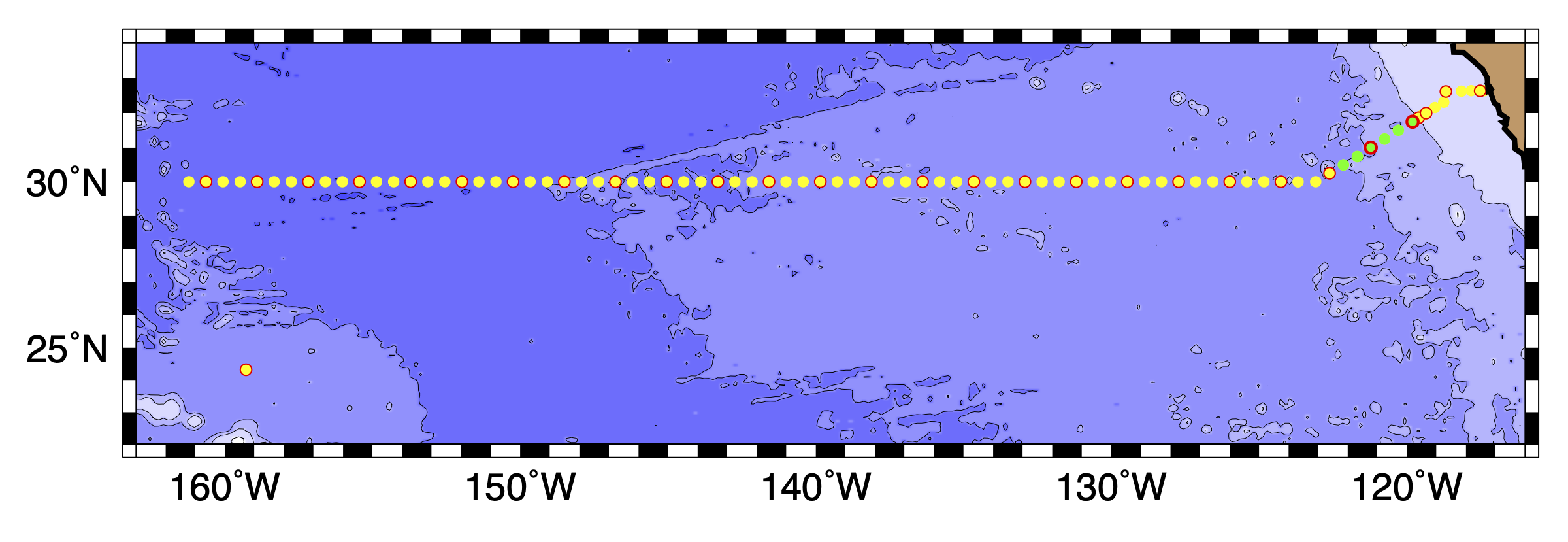GO-SHIP P02E 2022 Hydrographic Program¶
Summary¶
The 2022 reoccupation of leg 2 of the GO-SHIP P02 hydrographic line, RR2205 (Fig. 1), included 130 profiles collected on 89 stations using a 36-bottle rosette. This includes a shallow test dip carried out on the way to the first station of the section, reoccupation of 10 stations in the California Current region near the eastern end of the section, as well as 1000-m casts for the BIO-GO-SHIP 1 program collected on every third station. Additionally, four GO_BGC floats with biochemical sensors were deployed. All floats were deployed on stations with bio profiles, using an extended bottle sampling schedule. Most of the P2 section, including the entire zonal component along 30N, was collected with the target 30nm station spacing. For the 2022 occupation it was decided to follow mostly the original cross-slope/-shelf approach to the Californian coast from the 1993 WOCE cruises, which coincides with the southernmost repeat section of the CalCOFI program. One of the stations had to be moved slightly because of Navy operations in the area. Stations along this approach were spaced less than 30nm apart, with particularly close spacing over the steep continental slope. The rosette instruments included a pumped CTD with dual temperature and conductivity lines, one with oxygen (SBE43), a secondary separate RINKO oxygen sensor, fluorometer, transmissometer, upward and downward-looking LADCPs, an underwater vision profiler (UVP), two upward-looking and one downward-looking Chi-POD. Niskin bottle samples were collected and analyzed for the standard GO-SHIP set of parameters. Along all transits continuous underway shipboard multibeam bathymetry, TSG, met and pCO2 data were collected and a flow-through cytometer was run. The SADCP ran continuously. The EK-80 ran during each cast. There was also discrete underway sampling three times a day that included HPLC, POM, POC/N and DNA/RNA. See individual sections for further detail.

Red rings: Bio stations. Green: stations of the partial re-occupation of the CCS with two full profiles (bio stations also have 2 bio profiles).¶
In spite of the failure of the primary winch after the first deep profile there were no significant delays due to technical problems. Therefore, and also because of the perfect weather and sea state prevailing during the cruise, the full science plan could be carried out, including an optional partial second crossing of the California Current system. Preliminary results include observations of strong climate-change trends in the abyssal temperatures and salinities in the subtropical gyre since the previous occupation of P02 in 2013, as well as the mapping of a large plume of SF6 in the eastern part of the section, that is likely caused by the propulsion system of a particular type of Navy torpedoes.
Programs and Principal Investigators¶
Program |
Affiliation |
Principal Investigator |
|
|---|---|---|---|
BGC Floats |
Lynne Talley |
||
C13 & C14 |
Rolf Sonnerup, Roberta Hansman |
||
Dong-Ha Min |
|||
Chipods |
Jonathan Nash |
||
CTDO Data, Salinity, Nutrients, Dissolved O2 |
Susan Becker, Todd Martz |
||
Underway pCO2 |
Simone Alin |
||
Craig Carlson |
|||
Lowered ADCP |
Andreas Thurnherr |
||
Adam Martiny |
|||
Shipboard ADCP |
Julia Hummon |
||
Total Alkalinity, pH |
Andrew Dickson |
||
Total CO2 (DIC) |
Richard Feely |
||
Transmissometer |
Adam Martiny, Jason Graff |
||
UVP-5 |
Andrew McDonnell |
||
Viral Abundance |
Ben Temperton |
Science Team and Responsibilities¶
Duty |
Name |
Affiliation |
Email Address |
|---|---|---|---|
Chief Scientist |
Andreas Thurnherr |
||
Co-Chief Scientist |
Sebastien Bigorre |
||
CTD Watchstander |
Bailey Amos |
||
CTD Watchstander |
Turner Johnson |
||
CTD Watchstander |
Alyssa Schultz |
||
CTD Watchstander |
Dylan Shafer |
||
Nutrients |
John Ballard |
||
Nutrients |
Tania Leung |
||
CTDO Processing, Database Management |
Michael Kovatch |
||
Salts, Marine Technician |
Gabriel Matthias |
||
Salts |
Laurette Roy |
||
Marine Technician |
Mason Schettig |
||
CR Technician |
Howell Johnson |
||
CR Technician |
Maya Thompson |
||
Dissolved O2 |
Elisa Aitoro |
||
Dissolved O2 |
Robert “Ben” Freiberger |
||
LADCP |
Lilian Dove |
||
Bio/Imaging |
Skylar Gerace |
||
Bio/Genomics |
Sydney Lewis |
||
Total Alkalinity |
Daniela Nestory |
||
Total Alkalinity |
Sidney Wayne |
||
pH |
Brison Grey |
||
pH |
Albert Ortiz |
||
Andrew Collins |
|||
Charles Featherstone |
|||
David Cooper |
|||
Carol Gonzalez |
|||
Matthew Varas |
|||
Michelle Michelsen |
- 1
Throughout “core” refers to the regular (GO-SHIP levels 1-2) sampling and “bio” refers to the biology sampling performed by the Bio GO-SHIP team. See Bio section of this report for the details on the bio sampling.